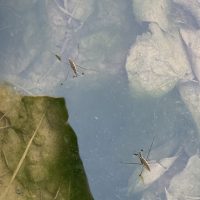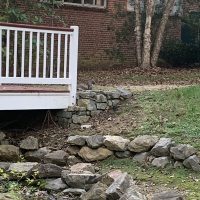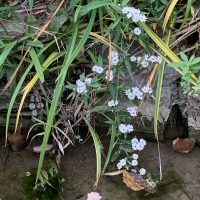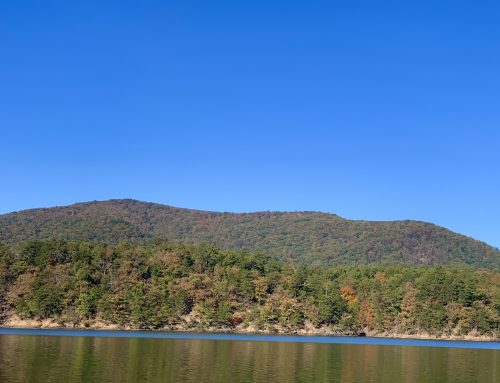In my fifteen minutes of focus this week, I noticed that the stream striders on the water are still going strong, and that there seem to be significantly more leaves in the streambed this time than there were when I last visited. As far as other insects go, this time I noticed a couple little brown dock spiders on one of the rocks between the stream and me, and only a couple of no-see-ems, unlike the weeks before now. Across the stream from where I was sitting, to the north of me, I noticed some small, white flowers. They’ve always been there, but now that the orange jewelweed has lost its flowers, I’m starting to notice it more. There were also a number of really active squirrels burying things and climbing trees.
When I closed my eyes and tuned in, it was pretty disarming. Unlike when I tune in normally, I felt a little uneasy. At first, the sounds were like what I would usually hear- leaves rustling in the tress, the crickets chirping, and a couple different birds cawing from places around me. I was made more aware of other things, like the stream flowing at point where there’s a steeper drop further along, or the snapping of twigs and crunching of leaves. But then I heard this startling rattling sound from directly above me! So naturally, I opened my eyes and saw that there was a pine tree branch overhead, very near to where I was sitting, but I couldn’t place the cause of the noise… yet.



So, from left to right, using iNaturalist, I was able to categorize the organisms in the photos as the following: common water strider (Gerris lacustris), eastern gray squirrel (Sciurus carolinensis), and calico aster (Symphyotrichum lateriflorum). In my research, I found that water striders are carnivorous (!) and eat mosquito larvae (great job, water striders!), calico aster is great for attracting pollinators like bees, and eastern gray squirrels have peripheral vision just as good as their focal vision- so they don’t need to turn their heads to see what’s going on around them.
After identifying and photographing which three things I was going to plug into iNaturalist, I set onto the next part of this assignment- documenting the behavior of an organism. I started doing this using one of the striders, but no offense to them, they were pretty monotonous. So instead, I decided to focus on a squirrel that barreled its way down the pine tree next to me. I watched it hop around and stuff its mouth full of leaves (???) on multiple occasions, and then, at the end of my time watching it, it ran back up the pine, and made that awful rattling/scratching noise as the leaves brushed a pine tree branch on its way to a nest!


Wow I like how you actually know the names of the organisms you are referring to (unlike me). I can only bow down before your great brain of ecological knowledge! We love to see water striders eating mosquito larvae because I am tired of bug bites; I think I have permanent bug bite scars 🙁 That’s really iconic of your squirrel to chow down on leaves (it is bulking season after all)- go Hollins squirrels!!!
Nice blog Cheyenne – maybe you feel exposed so closing your eyes makes you feel vulnerable in your spot?